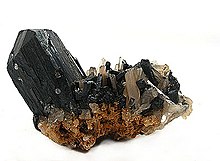
Hornblende is a complex inosilicate series of minerals. It is not a recognized mineral in its own right, but the name is used as a general or field term, to refer to a dark amphibole. Hornblende minerals are common in igneous and metamorphic rocks.

Actinolite is an amphibole silicate mineral with the chemical formula Ca2(Mg4.5-2.5Fe2+0.5-2.5)Si8O22(OH)2.
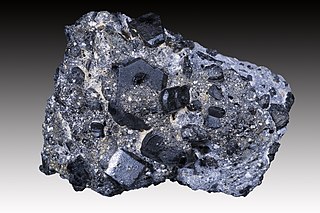
Augite is a common rock-forming pyroxene mineral with formula (Ca,Na)(Mg,Fe,Al,Ti)(Si,Al)2O6. The crystals are monoclinic and prismatic. Augite has two prominent cleavages, meeting at angles near 90 degrees.
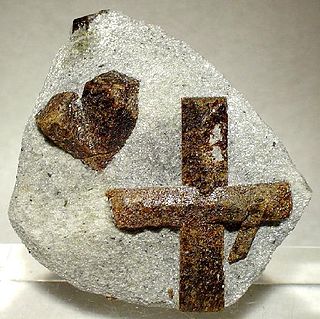
Staurolite is a reddish brown to black, mostly opaque, nesosilicate mineral with a white streak. It crystallizes in the monoclinic crystal system, has a Mohs hardness of 7 to 7.5 and the chemical formula: Fe2+2Al9O6(SiO4)4(O,OH)2. Magnesium, zinc and manganese substitute in the iron site and trivalent iron can substitute for aluminium.

Franklinite is an oxide mineral belonging to the normal spinel subgroup's iron (Fe) series, with the formula Zn2+Fe23+O4.
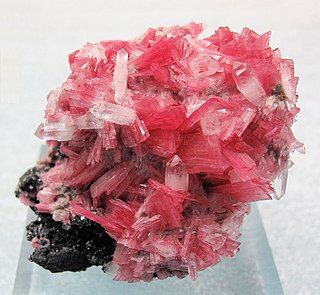
Rhodonite is a manganese inosilicate, with the formula (Mn, Fe, Mg, Ca)SiO3, and member of the pyroxenoid group of minerals, crystallizing in the triclinic system. It commonly occurs as cleavable to compact masses with a rose-red color (its name comes from Ancient Greek ῥόδον (rhódon) 'rose'), often tending to brown due to surface oxidation. The rose-red hue is caused by the manganese cation (Mn2+).

Samarskite is a radioactive rare earth mineral series which includes samarskite-(Y), with the chemical formula (YFe3+Fe2+U,Th,Ca)2(Nb,Ta)2O8 and samarskite-(Yb), with the chemical formula (YbFe3+)2(Nb,Ta)2O8. The formula for samarskite-(Y) is also given as (Y,Fe3+,U)(Nb,Ta)O4.
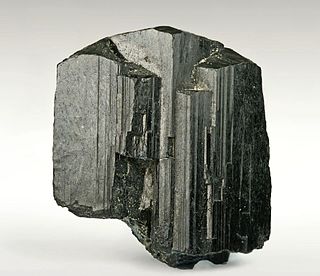
Arfvedsonite is a sodium amphibole mineral with composition: [Na][Na2][(Fe2+)4Fe3+][(OH)2|Si8O22]. It crystallizes in the monoclinic prismatic crystal system and typically occurs as greenish black to bluish grey fibrous to radiating or stellate prisms.

Allanite (also called orthite) is a sorosilicate group of minerals within the broader epidote group that contain a significant amount of rare-earth elements. The mineral occurs mainly in metamorphosed clay-rich sediments and felsic igneous rocks. It has the general formula A2M3Si3O12[OH], where the A sites can contain large cations such as Ca2+, Sr2+, and rare-earth elements, and the M sites admit Al3+, Fe3+, Mn3+, Fe2+, or Mg2+ among others. However, a large amount of additional elements, including Th, U, Be, Zr, P, Ba, Cr and others may be present in the mineral. The International Mineralogical Association lists four minerals in the allanite group, each recognized as a unique mineral: allanite-(Ce), allanite-(La), allanite-(Nd), and allanite-(Y), depending on the dominant rare earth present: cerium, lanthanum, neodymium or yttrium.

Aegirine is a member of the clinopyroxene group of inosilicate minerals. Aegirine is the sodium endmember of the aegirine-augite series. Aegirine has the chemical formula NaFeSi2O6 in which the iron is present as Fe3+. In the aegirine-augite series the sodium is variably replaced by calcium with iron(II) and magnesium replacing the iron(III) to balance the charge. Aluminium also substitutes for the iron(III). Acmite is a fibrous, green-colored variety.

Aenigmatite, also known as Cossyrite after Cossyra, the ancient name of Pantelleria, is a sodium, iron, titanium inosilicate mineral. The chemical formula is Na2Fe2+5TiSi6O20 and its structure consists of single tetrahedral chains with a repeat unit of four and complex side branches. It forms brown to black triclinic lamellar crystals. It has Mohs hardness of 5.5 to 6 and specific gravity of 3.74 to 3.85. Aenigmatite forms a solid-solution series with wilkinsonite, Na2Fe2+4Fe3+2Si6O20.

Babingtonite is a calcium iron manganese inosilicate mineral with the formula Ca2(Fe,Mn)FeSi5O14(OH). It is unusual in that iron(III) completely replaces the aluminium so typical of silicate minerals. It is a very dark green to black translucent mineral crystallizing in the triclinic system with typically radial short prismatic clusters and druzy coatings. It occurs with zeolite minerals in cavities in volcanic rocks. Babingtonite contains both iron(II) and iron(III) and shows weak magnetism. It has a Mohs hardness of 5.5 to 6 and a specific gravity of 3.3.

Chloritoid is a silicate mineral of metamorphic origin. It is an iron magnesium manganese alumino-silicate hydroxide with formula (Fe, Mg, Mn)
2Al
4Si
2O
10(OH)
4. It occurs as greenish grey to black platy micaceous crystals and foliated masses. Its Mohs hardness is 6.5, unusually high for a platy mineral, and it has a specific gravity of 3.52 to 3.57. It typically occurs in phyllites, schists and marbles.
Zircophyllite is a complex mineral, formula (K,Na)3(Mn,Fe)2+7(Zr,Ti,Nb)2Si8O24(OH,F)7. It crystallizes in the triclinic - pinacoidal crystal class as dark brown to black micaceous plates. It has perfect 001 cleavage, a Mohs hardness of 4 to 4.5 and a specific gravity of 3.34. Its indices of refraction are nα=1.708 nβ=1.738 nγ=1.747 and it has a 2V optical angle of 62°.
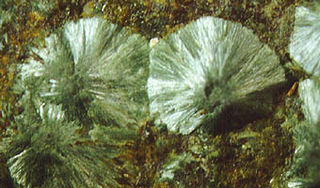
Pumpellyite is a group of closely related sorosilicate minerals:
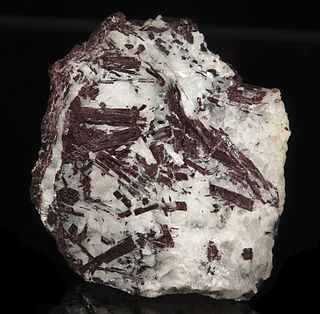
Piemontite is a sorosilicate mineral in the monoclinic crystal system with the chemical formula Ca2(Al,Mn3+,Fe3+)3(SiO4)(Si2O7)O(OH). It is a member of the epidote group.

Stilpnomelane is a phyllosilicate mineral. It has the chemical formula K(Fe2+,Mg,Fe3+)8(Si,Al)12(O,OH)27·n(H2O).
Campigliaite is a copper and manganese sulfate mineral with a chemical formula of Cu4Mn(SO4)2(OH)6·4H2O. It has a chemical formula and also a crystal structure similar to niedermayrite, with Cd(II) cation replacing by Mn(II). The formation of campigliaite is related to the oxidation of sulfide minerals to form sulfate solutions with ilvaite associated with the presence of manganese. Campigliaite is a rare secondary mineral formed when metallic sulfide skarn deposits are oxidized. While there are several related associations, there is no abundant source for this mineral due to its rare process of formation. Based on its crystallographic data and chemical formula, campigliaite is placed in the devillite group and considered the manganese analogue of devillite. Campigliaite belongs to the copper oxysalt minerals as well followed by the subgroup M=M-T sheets. The infinite sheet structures that campigliaite has are characterized by strongly bonded polyhedral sheets, which are linked in the third dimension by weaker hydrogen bonds.

Pseudobrookite is an iron titanium oxide mineral with formula: Fe2TiO5 or (Fe3+,Fe2+)2(Ti,Fe2+)O5.
Achalaite ((Fe2+, Mn)(Ti, Fe3+, Ta)(Nb, Ta)2O8) is a black mineral of the wodginite group, first discovered in 2013.
